Thermal Performance of the Thin Heat Pipe for Cooling of Solid-State Drives
Abstract
:1. Introduction
2. Materials and Methods
2.1. Experiment Methods and Conditions
2.2. Data Processing and Uncertainty Analysis
3. Experimental Results and Discussion
3.1. Startup Performance of SSD Heat Sink
3.2. Effect of Working Parameters
3.2.1. Heat Input
3.2.2. Quantities of THP
3.2.3. Position of the Heat Sink
3.3. Simulation for the SSD Heat Sink
3.3.1. Simulation Parameters
3.3.2. Simulation Results
4. Conclusions
Author Contributions
Funding
Data Availability Statement
Conflicts of Interest
References
- Ajayan, J.; Nirmal, D.; Tayal, S.; Bhattacharya, S.; Arivazhagan, L.; Fletcher, A.S.A.; Muruga Pandiyan, P.; Ajitha, D. Nanosheet field effect transistors—A next generation device to keep Moore’s law alive: An intensive study. Microelectron. J. 2021, 114, 105141. [Google Scholar] [CrossRef]
- Jiang, D.; Liu, S.; Tang, W. Fabrication and Manipulation of Non-Spherical Particles in Microfluidic Channels: A Review. Micromachines 2022, 13, 1659. [Google Scholar] [CrossRef]
- Ho, C.J.; Liu, Y.C.; Ghalambaz, M.; Yan, W.-M. Forced convection heat transfer of Nano-Encapsulated Phase Change Material (NEPCM) suspension in a mini-channel heatsink. Int. J. Heat Mass Transf. 2020, 155, 119858. [Google Scholar] [CrossRef]
- Salman, O.H.; Taha, Z.; Al-Sabah, M.Q.; Hussein, Y.S.; Mohammed, A.S.; Aal-Nouman, M. A review on utilizing machine learning technology in the fields of electronic emergency triage and patient priority systems in telemedicine: Coherent taxonomy, motivations, open research challenges and recommendations for intelligent future work. Comput. Methods Programs Biomed. 2021, 209, 106357. [Google Scholar] [CrossRef] [PubMed]
- Jayaramu, P.; Gedupudi, S.; Das, S.K. Experimental investigation of the influence of boiling-induced ageing on high heat flux flow boiling in a copper microchannel. Int. J. Heat Mass Transf. 2021, 181, 121862. [Google Scholar]
- Bailey, C. Thermal Management Technologies for Electronic Packaging: Current Capabilities and Future Challenges for Modelling Tools. In Proceedings of the EPTC: 2008 10th Electronic Packaging Technology Conference, Singapore, 9–12 December 2008; Volume 1–3, pp. 527–532. [Google Scholar]
- Iturriaga, S.; Nesmachnow, S. Scheduling Energy Efficient Data Centers Using Renewable Energy. Electronics 2016, 5, 71. [Google Scholar] [CrossRef] [Green Version]
- Zhao, N.; Qi, C.; Chen, T.; Tang, J.; Cui, X. Experimental study on influences of cylindrical grooves on thermal efficiency, exergy efficiency and entropy generation of CPU cooled by nanofluids. Int. J. Heat Mass Transf. 2019, 135, 16–32. [Google Scholar] [CrossRef]
- Korpyś, M.; Al-Rashed, M.; Dzido, G.; Wójcik, J. CPU Heat Sink Cooled by Nanofluids and Water: Experimental and Numerical Study. In Proceedings of the 23rd European Symposium on Computer Aided Process Engineering, Lappeenranta, Finland, 9–12 June 2013; pp. 409–414. [Google Scholar]
- Solodov, D.; Solodov, I. Data recovery in a case of fire-damaged Hard Disk Drives and SSDs. Forensic Sci. Int. Rep. 2021, 3, 100199. [Google Scholar] [CrossRef]
- Farjallah, E.; Armani, J.M.; Gherman, V.; Dilillo, L. Improvement of the tolerated raw bit error rate in NAND flash-based SSDs with selective refresh. Microelectron. Reliab. 2019, 96, 37–45. [Google Scholar] [CrossRef]
- Fukami, A.; Ghose, S.; Luo, Y.; Cai, Y.; Mutlu, O. Improving the reliability of chip-off forensic analysis of NAND flash memory devices. Digit. Investig. 2017, 20, S1–S11. [Google Scholar] [CrossRef]
- Tokutomi, T.; Tanakamaru, S.; Iwasaki, T.O.; Takeuchi, K. Advanced error-prediction LDPC with temperature compensation for highly reliable SSDs. Solid-State Electron. 2015, 111, 129–140. [Google Scholar] [CrossRef]
- Coutet, J.; Marc, F.; Dozolme, F.; Guétard, R.; Janvresse, A.; Lebossé, P.; Pastre, A.; Clement, J.C. Influence of temperature of storage, write and read operations on multiple level cells NAND flash memories. Microelectron. Reliab. 2018, 88–90, 61–66. [Google Scholar] [CrossRef]
- Kim, M.; Chun, M.; Hong, D.; Kim, Y.; Cho, G.; Lee, D.; Kim, J. RealWear: Improving performance and lifetime of SSDs using a NAND aging marker. Perform. Eval. 2021, 145, 102153. [Google Scholar] [CrossRef]
- Kumar, A.; Kothari, R.; Sahu, S.K.; Kundalwal, S.I. A comparative study and optimization of phase change material-based heat sinks for thermal management of electronic components. J. Energy Storage 2021, 43, 103224. [Google Scholar] [CrossRef]
- Huang, C.H.; Wu, Y.T. An optimum design for a natural convection pin fin array with orientation consideration. Appl. Therm. Eng. 2021, 188, 116633. [Google Scholar] [CrossRef]
- Lee, I.; Kim, S.J. Topology optimization of a heat sink with an axially uniform cross-section cooled by forced convection. Int. J. Heat Mass Transf. 2021, 168, 120732. [Google Scholar] [CrossRef]
- Veerasamy, A.; Balakrishnan, K.; Abdul Razack, S. Performance of heat pipe with nanorefrigerant in electronic cooling applications. Mater. Today Proc. 2022, 65, 375–379. [Google Scholar] [CrossRef]
- Koukoravas, T.P.; Damoulakis, G.; Megaridis, C.M. Experimental investigation of a vapor chamber featuring wettability-patterned surfaces. Appl. Therm. Eng. 2020, 178, 115522. [Google Scholar] [CrossRef]
- Anand, R.S.; Jawahar, C.P.; Brusly Solomon, A.; David, S.; Bellos, E.; Said, Z. Experimental investigations on modified thermosyphons using R134a/Al2O3 and comparative machine learning analysis. Appl. Therm. Eng. 2022, 212, 118554. [Google Scholar] [CrossRef]
- Paniagua-Guerra, L.E.; Sehgal, S.; Gonzalez-Valle, C.U.; Ramos-Alvarado, B. Fractal channel manifolds for microjet liquid-cooled heat sinks. Int. J. Heat Mass Transf. 2019, 138, 257–266. [Google Scholar] [CrossRef]
- Gorzin, M.; Ranjbar, A.A.; Hosseini, M.J. Experimental and numerical investigation on thermal and hydraulic performance of novel serpentine minichannel heat sink for liquid CPU cooling. Energy Rep. 2022, 8, 3375–3385. [Google Scholar] [CrossRef]
- Wei, W.H.; Shang, Y.Y.; Peng, Y.; Cong, R. Research Progress of Noise in High-Speed Cutting Machining. Sensors 2022, 22, 3851. [Google Scholar] [CrossRef]
- Jia, X.D.; Zhou, Y.; Wang, Y.N. Deformation Behavior and Constitutive Model of 34CrNi3Mo during Thermo-Mechanical Deformation Process. Materials 2022, 15, 5220. [Google Scholar] [CrossRef]
- Koito, Y. Numerical analyses on heat transfer characteristics of ultra-THPs: Fundamental studies with a three-dimensional thermal-fluid model. Appl. Therm. Eng. 2019, 148, 430–437. [Google Scholar] [CrossRef]
- Zhou, W.; Li, Y.; Chen, Z.; Deng, L.; Gan, Y. A novel ultra-thin flattened heat pipe with biporous spiral woven mesh wick for cooling electronic devices. Energy Convers. Manag. 2019, 180, 769–783. [Google Scholar] [CrossRef]
- Chen, A.; Jiang, F.; Dong, J.; Chen, J.; Zhu, Y. Design, fabrication and thermal performance of a novel ultra-thin loop heat pipe with printed wick structure for mobile electronics cooling. Appl. Therm. Eng. 2022, 200, 117683. [Google Scholar] [CrossRef]
- Ji, Y.; Yuan, D.; Hao, Y.; Tian, Z.; Lou, J.; Wu, Y. Experimental study on heat transfer performance of high temperature heat pipe with large length-diameter ratio for heat utilization of concentrated solar energy. Appl. Therm. Eng. 2022, 215, 118918. [Google Scholar] [CrossRef]
- Lee, K.; Kang, M.; Hwang, Y.; Shin, H. Accurate Lifetime Estimation of Sub-20-nm NAND Flash Memory. IEEE Trans. Electron Devices 2016, 63, 659–667. [Google Scholar] [CrossRef]
- Ho, C.J.; Liu, Y.C.; Yang, T.F.; Ghalambaz, M.; Yan, W.M. Convective heat transfer of nano-encapsulated phase change material suspension in a divergent minichannel heatsink. Int. J. Heat Mass Transf. 2021, 165, 120717. [Google Scholar] [CrossRef]

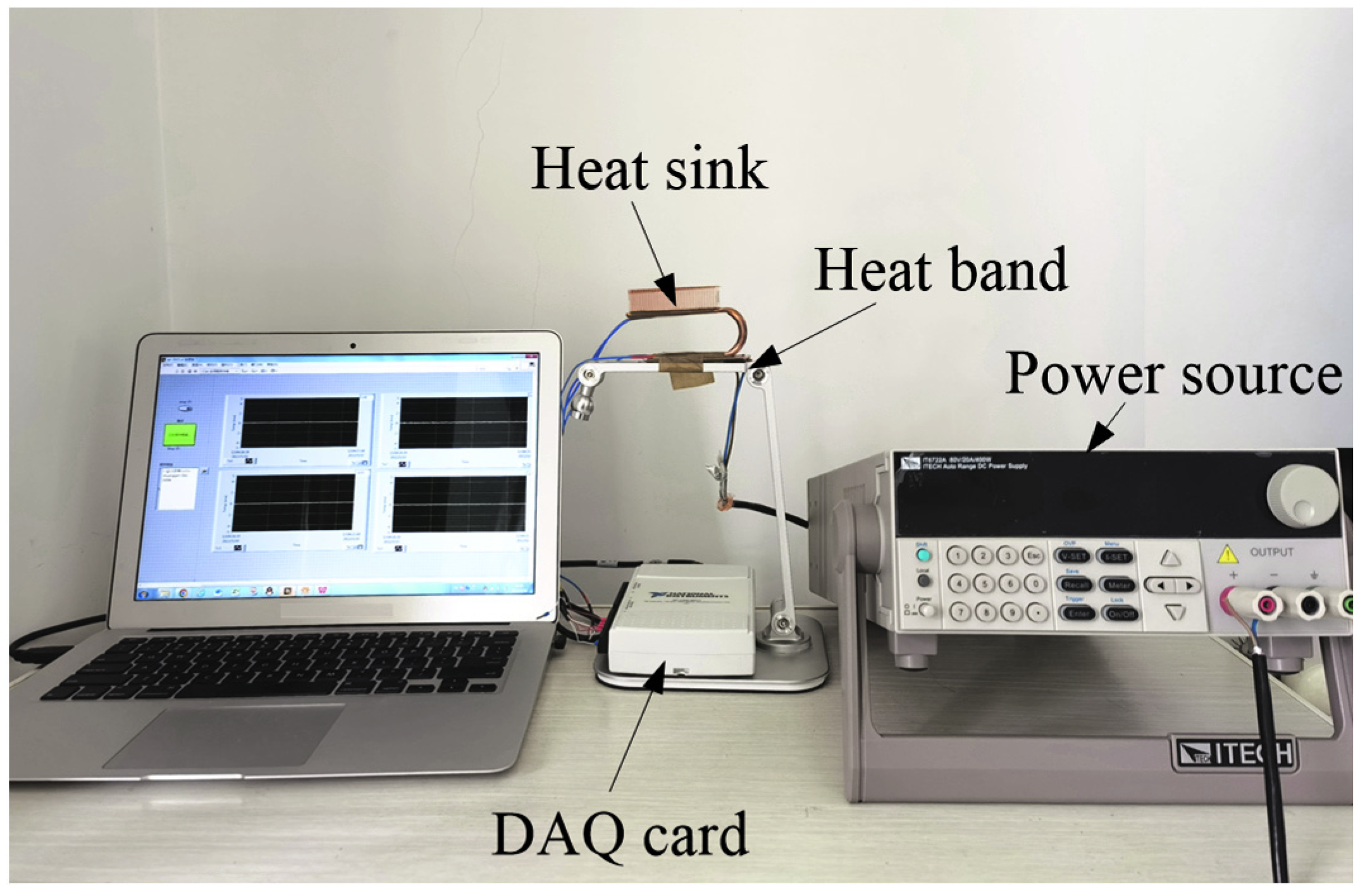


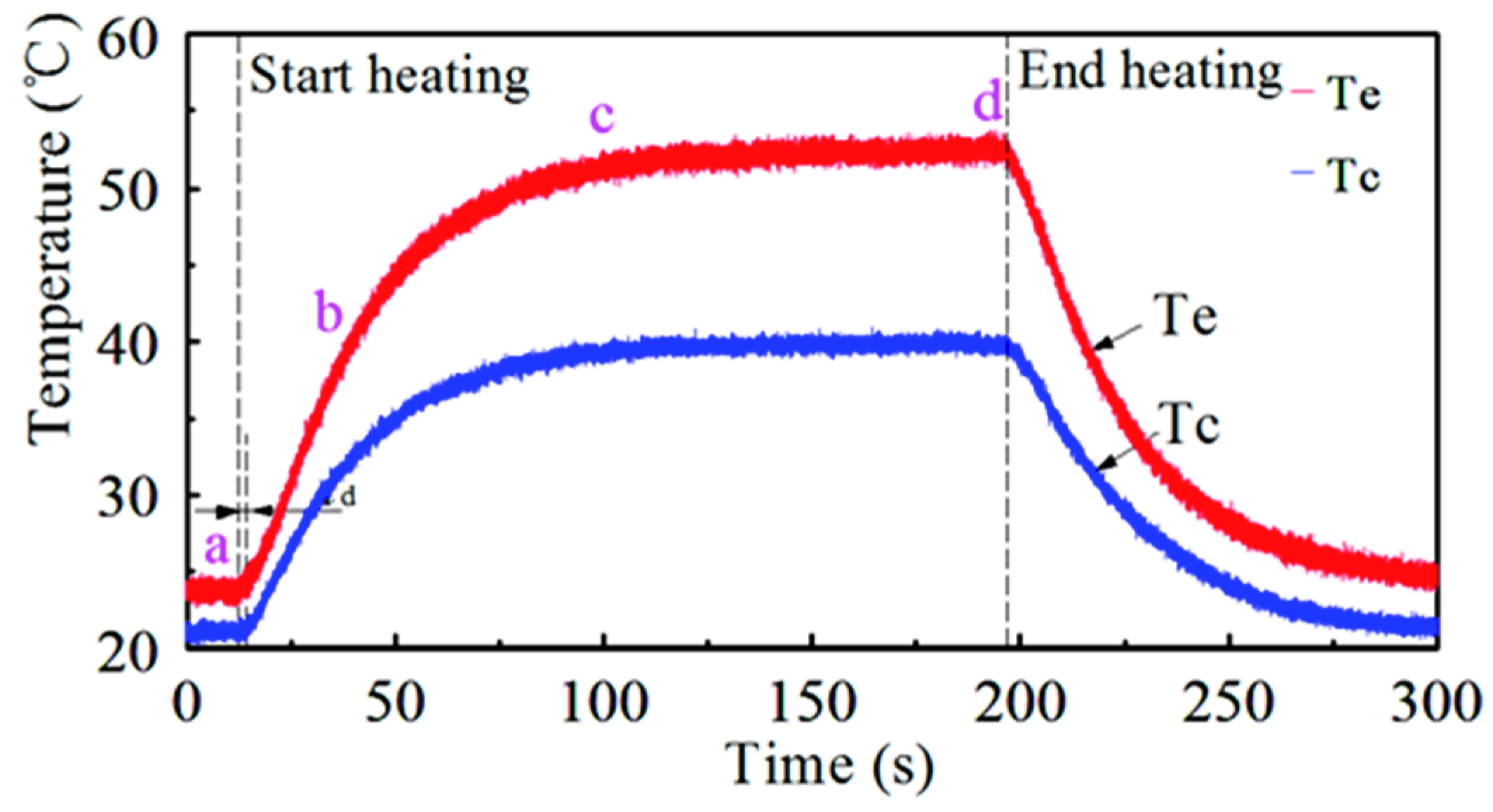
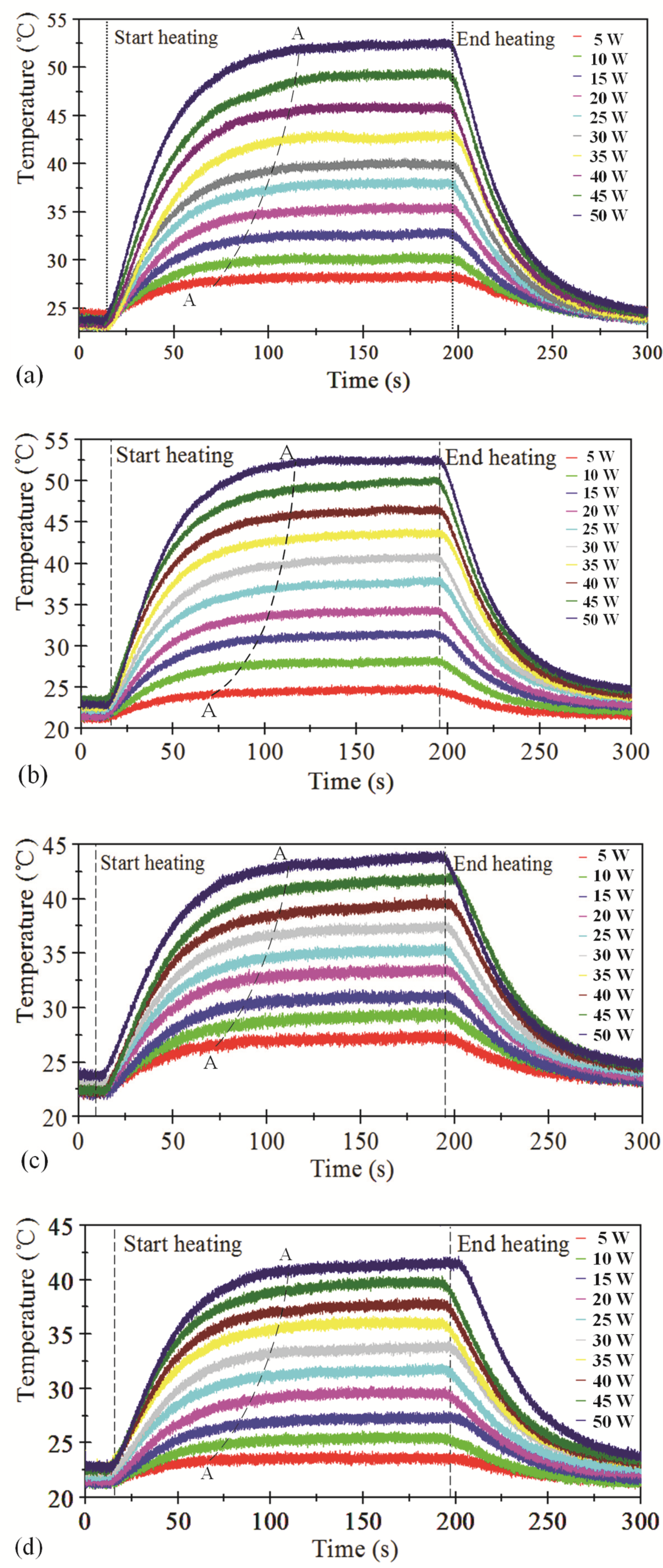
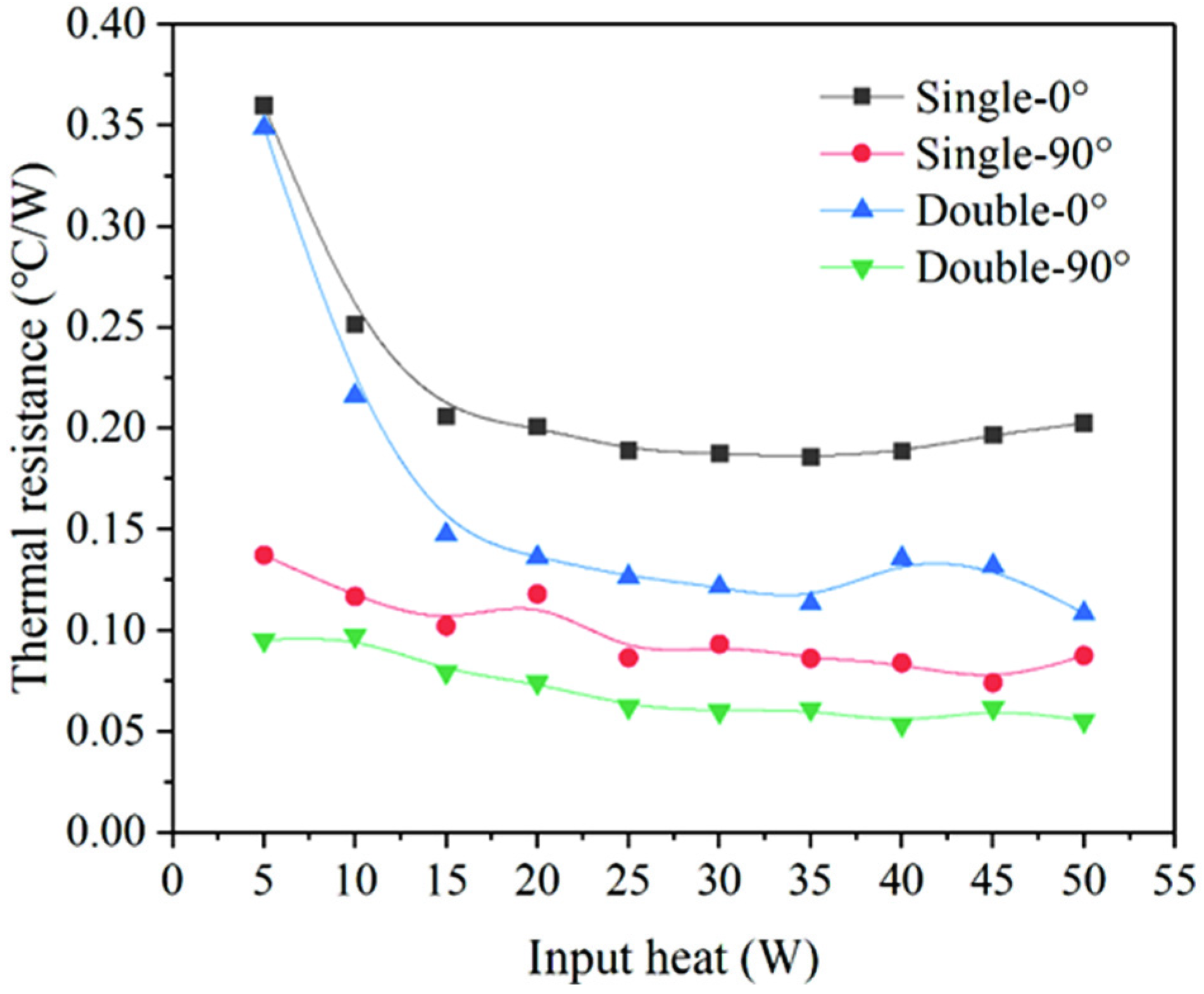
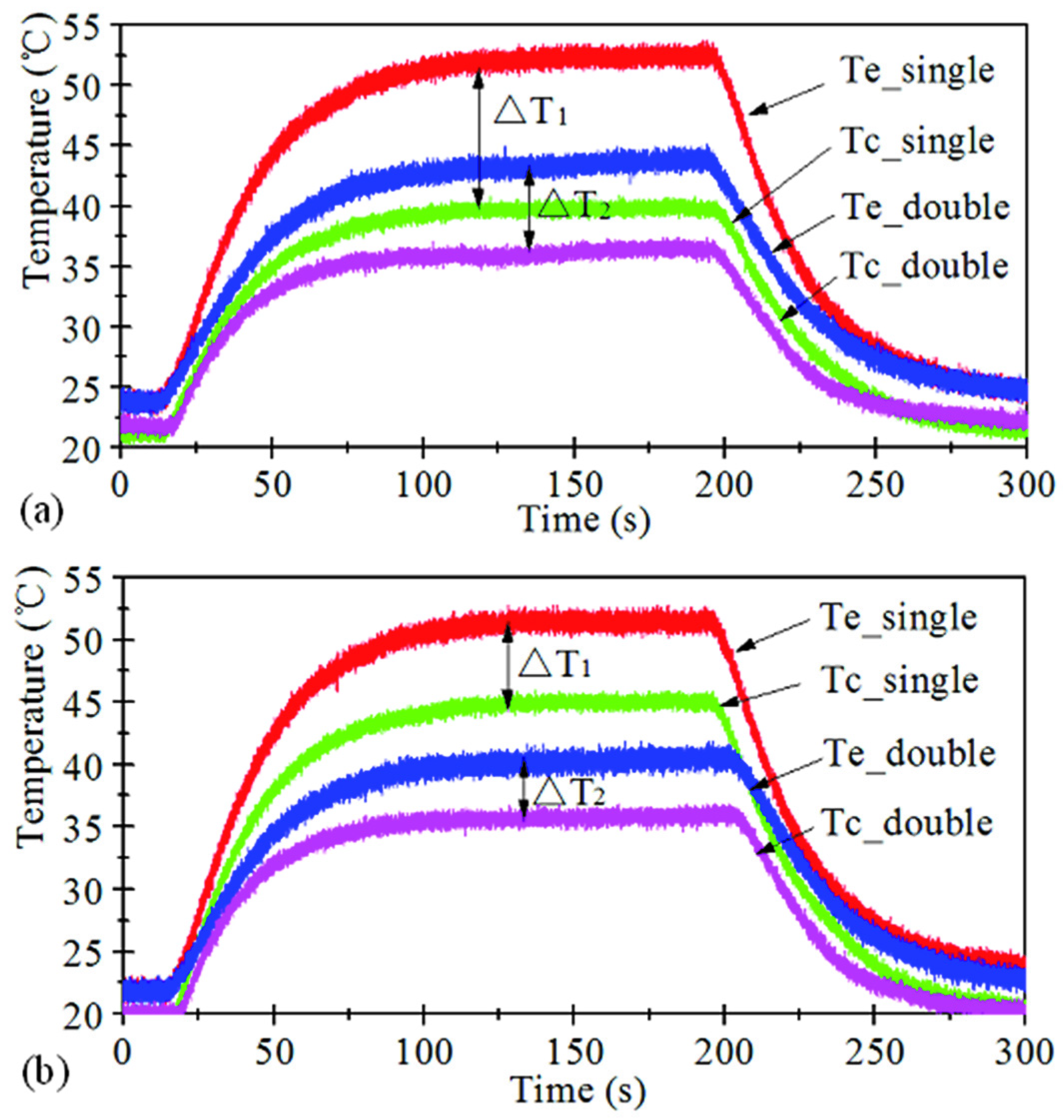



| Dimension Parameters | Value (mm) |
|---|---|
| SSD (L × W × H) | 80 × 22 × 2 |
| Copper plate (L × W × H) | 70 × 20 × 1 |
| Band heater (L × W) | 70 × 20 |
| Heat pipe cross section (L × H) | 7 × 0.4 |
| Copper fin (L × W × H) | 61 × 25 × 19 |
| Fin spacing | 2 |
| Parameter | Value |
|---|---|
| Heat input Q (W) | 5; 10; 15; 20; 25; 30; 35; 40; 45; 50 |
| Position of the heat sink | 0°; 90° |
| Filling ratio φ (%) | 10% |
| Working fluid type | Deionized water |
| Cooling air temperature for the condenser | 20 °C |
| Parameter | Te | Tc | U | I | Q | R |
|---|---|---|---|---|---|---|
| Maximum uncertainty (%) | ±1.2 | ±1.2 | ±0.01 | ±0.1 | 0.1 | 1.7 |
| Items | Parameters |
|---|---|
| Material | Coppers |
| Density (kg/m3) | 8978 |
| Cp (Specific Heat) (J/kg·K) | 381 |
| Thermal Conductivity (W/m·K) | 387.6 |
| Heat Input (W) | Simulation Results (T1/°C) | Experiment Results (T2/°C) | Error (M/%) |
|---|---|---|---|
| 5 | 26.81 | 26.97 | 0.59 |
| 10 | 29.38 | 29.18 | 0.68 |
| 15 | 31.51 | 30.89 | 2.01 |
| 20 | 32.74 | 33 | 0.76 |
| 25 | 34.21 | 34.75 | 1.55 |
| 30 | 35.68 | 36.48 | 2.19 |
| 35 | 37.97 | 38.26 | 0.76 |
| 40 | 39.13 | 40.06 | 2.32 |
| 45 | 41.62 | 42.23 | 1.37 |
| 50 | 42.12 | 43.66 | 3.53 |
Publisher’s Note: MDPI stays neutral with regard to jurisdictional claims in published maps and institutional affiliations. |
© 2022 by the authors. Licensee MDPI, Basel, Switzerland. This article is an open access article distributed under the terms and conditions of the Creative Commons Attribution (CC BY) license (https://creativecommons.org/licenses/by/4.0/).
Share and Cite
Yuan, D.; Chen, J.; Yang, Y.; Zhang, L.; Liu, S.; Jiang, H.; Qian, N. Thermal Performance of the Thin Heat Pipe for Cooling of Solid-State Drives. Metals 2022, 12, 1786. https://doi.org/10.3390/met12111786
Yuan D, Chen J, Yang Y, Zhang L, Liu S, Jiang H, Qian N. Thermal Performance of the Thin Heat Pipe for Cooling of Solid-State Drives. Metals. 2022; 12(11):1786. https://doi.org/10.3390/met12111786
Chicago/Turabian StyleYuan, Dongdong, Jiajia Chen, Yong Yang, Liyong Zhang, Songyan Liu, Huafei Jiang, and Ning Qian. 2022. "Thermal Performance of the Thin Heat Pipe for Cooling of Solid-State Drives" Metals 12, no. 11: 1786. https://doi.org/10.3390/met12111786
APA StyleYuan, D., Chen, J., Yang, Y., Zhang, L., Liu, S., Jiang, H., & Qian, N. (2022). Thermal Performance of the Thin Heat Pipe for Cooling of Solid-State Drives. Metals, 12(11), 1786. https://doi.org/10.3390/met12111786






